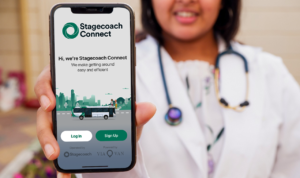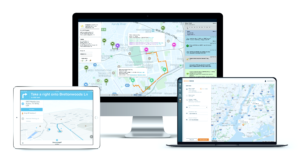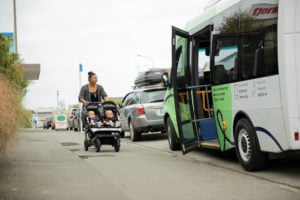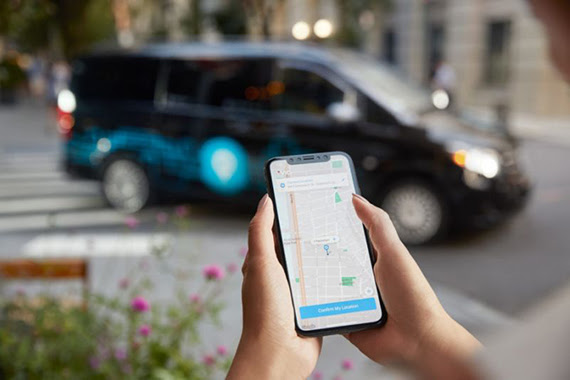The world is undergoing a transportation revolution as cities, public transport authorities, private companies, and even universities expand their commitment and investment in demand-responsive transport.
The idea of developing a custom DRT network has its appeal anchored in an age where traffic congestion is at an all-time high and public transport ridership continues to fall, a trend that’s only been intensified in the wake of COVID-19 — bus ridership in Britain declined by nearly 8 percent over the last decade.
The reason may be that the appetite for demand-responsive ride-hailing has reached a fever pitch, and when managed improperly, cities are paying the consequences. A traffic congestion study commissioned by Uber and Lyft actually revealed the companies account for up to 14 percent of vehicle miles traveled in some cities, a reason why cities like New York are passing legislation directly aimed at how often cars cruise without passengers.
The growing interest in DRT, however, has transport leaders blending the best of both worlds by leveraging technology to build the public transport of tomorrow. By recognising that a new generation of riders want to travel in a demand-responsive fashion, cities can build a better version of the bus — one that operates dynamically, without routes and schedules, but still promotes safe, shared trips to cut down on congestion. Plus, the flexibility that DRT affords is more important than ever before in being able to adapt quickly as municipalities support their communities as they return to work and new routines.
Before carrying on, however, decision-makers should ask themselves the following questions:

What are the specific goals?
Before doing anything, it’s important to frame the challenges that demand-responsive transport is going to solve. What is the pressing need for this type of service?
King County Metro in Seattle invested in DRT as a first-and-last mile link to five of its light rail transit hubs where parking and alternative means of transit were both sparse. In Newton, Massachusetts, city leaders were specifically interested in increasing mobility for the city’s senior population, so they developed a program catering to residents over 60-years-old. In Abu Dhabi, the city’s public transportation authority was interested in supporting healthcare workers during COVID-19 with free on-demand rides to hospitals.
Whether it’s increasing public transport ridership, decreasing congestion, reducing the number of vehicles parked at local transport hubs, or giving residents or essential workers a more accessible way to travel, it’s important to have measurable goals before launching your DRT service.

How will you use the demand-responsive transport data?
Investing in new mobility technology via a public-private partnership can help provide more convenient community transport, eliminate areas with no access to transport, create first-and-last mile connections to transport hubs, and replace underutilised and inefficient bus routes — all while improving the environment by getting people out of private cars and away from single-occupancy vehicle trips.
Beyond the visible benefits, such partnerships also generate a treasure trove of data, giving transit authorities and operators a completely new vantage point into their communities’ specific needs. This data can support an array of new applications, like help leadership make major improvements to their overall transit system, understand where to shift resources to better serve riders, where to put a protected bike lane, or what low-income neighborhoods should have the most affordable public transit. It also has the potential to aid in contact tracing during a health crisis, and ensure vehicles meet sanitary and safety requirements that can help communities curb the further spread of COVID-19.
However, not every mobility technology company has always taken a collaborative approach to sharing rider data with cities and transit operators. Public transport authorities and operators (PTAs/PTOs) should partner with companies that will share robust data to help inform important decisions, faithfully comply with regulations, and protect customer privacy. As the transportation landscape continues to evolve, finding a mobility partner that is actually willing to share data to improve public transit is just as important as finding one that is serious about data security.

How will you measure demand-responsive transport's ROI?
Transport professionals already know that operating quality public transport is an expensive endeavor. For each dollar spent in operating costs per trip across all modes and all transit systems, an average of 19.2 cents are recovered through fares, according to Boston Consulting Group’s 2019 report, On-Demand Transit Can Unlock Urban Mobility.
DRT can enable a more efficient allocation of resources in areas with under-performing fixed routes, low population density, or logistically difficult to serve areas. Providing a sufficient return on investment, however, is about much more than simply evaluating the farebox recovery ratio.
Demand-responsive transport networks address a huge variety of underlying community issues, so it’s important to measure ROI through a broader lens. Efficient transport provides residents reliable access to jobs, shrinks cities, improves quality of life, and helps eliminate things like food deserts.
You shouldn’t have to live in central London, or be lucky or rich enough to live near a tube station or well-served bus line, to have access to high quality, convenient, and affordable public transport. Cities and transport authorities are increasingly turning to technology to facilitate their mandate of providing accessible and equitable transport to the passenger populations they service.
What happens if you do nothing?
Public transport ridership, along with the associated revenue, continues to decline, leading to increasingly challenging budget and transport situations for many cities. This trend, underpinned by demographic changes in public transport ridership and usage along with changing passenger expectations, is one that cities are increasingly trying to reverse. DRT and the accompanying data, flexibility, and digitisation it allows give the public sector one of many tools it can use to blunt these declines.
For most cities, the do-nothing scenario ends with more congestion, more vehicle emissions, and less equity for residents. Good public transport is about so much more than traffic; it’s about impacting job opportunities, safety, and overall quality of life for residents. When doing nothing is no longer an option, it’s time to consider what’s next.




